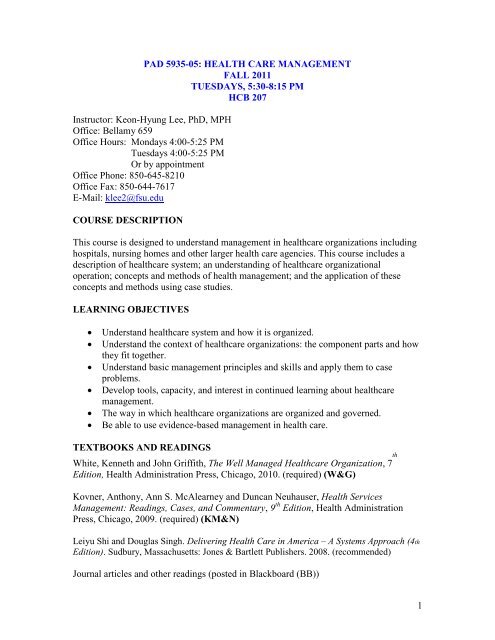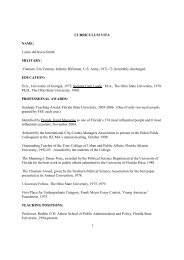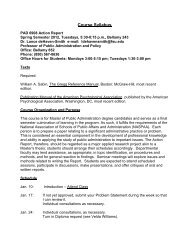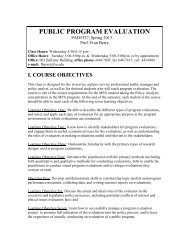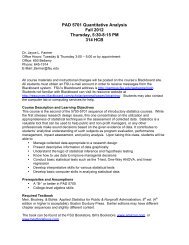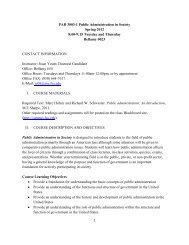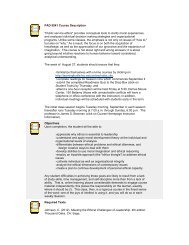pad health management - Askew School of Public Administration ...
pad health management - Askew School of Public Administration ...
pad health management - Askew School of Public Administration ...
- No tags were found...
You also want an ePaper? Increase the reach of your titles
YUMPU automatically turns print PDFs into web optimized ePapers that Google loves.
PAD 5935-05: HEALTH CARE MANAGEMENT<br />
FALL 2011<br />
TUESDAYS, 5:30-8:15 PM<br />
HCB 207<br />
Instructor: Keon-Hyung Lee, PhD, MPH<br />
Office: Bellamy 659<br />
Office Hours: Mondays 4:00-5:25 PM<br />
Tuesdays 4:00-5:25 PM<br />
Or by appointment<br />
Office Phone: 850-645-8210<br />
Office Fax: 850-644-7617<br />
E-Mail: klee2@fsu.edu<br />
COURSE DESCRIPTION<br />
This course is designed to understand <strong>management</strong> in <strong>health</strong>care organizations including<br />
hospitals, nursing homes and other larger <strong>health</strong> care agencies. This course includes a<br />
description <strong>of</strong> <strong>health</strong>care system; an understanding <strong>of</strong> <strong>health</strong>care organizational<br />
operation; concepts and methods <strong>of</strong> <strong>health</strong> <strong>management</strong>; and the application <strong>of</strong> these<br />
concepts and methods using case studies.<br />
LEARNING OBJECTIVES<br />
<br />
<br />
<br />
<br />
<br />
<br />
Understand <strong>health</strong>care system and how it is organized.<br />
Understand the context <strong>of</strong> <strong>health</strong>care organizations: the component parts and how<br />
they fit together.<br />
Understand basic <strong>management</strong> principles and skills and apply them to case<br />
problems.<br />
Develop tools, capacity, and interest in continued learning about <strong>health</strong>care<br />
<strong>management</strong>.<br />
The way in which <strong>health</strong>care organizations are organized and governed.<br />
Be able to use evidence-based <strong>management</strong> in <strong>health</strong> care.<br />
TEXTBOOKS AND READINGS<br />
White, Kenneth and John Griffith, The Well Managed Healthcare Organization, 7 th<br />
Edition, Health <strong>Administration</strong> Press, Chicago, 2010. (required) (W&G)<br />
Kovner, Anthony, Ann S. McAlearney and Duncan Neuhauser, Health Services<br />
Management: Readings, Cases, and Commentary, 9 th Edition, Health <strong>Administration</strong><br />
Press, Chicago, 2009. (required) (KM&N)<br />
Leiyu Shi and Douglas Singh. Delivering Health Care in America – A Systems Approach (4th<br />
Edition). Sudbury, Massachusetts: Jones & Bartlett Publishers. 2008. (recommended)<br />
Journal articles and other readings (posted in Blackboard (BB))<br />
1
COURSE REQUIREMENTS AND GRADING<br />
Students are expected to read and reflect upon assigned readings and prepared to discuss<br />
them. Grades will be based on the following requirements:<br />
Three Case Analyses (3×10%=30%): (4-page double-spaced)<br />
Weekly Critique <strong>of</strong> Readings and Participation (15%): (1-page single-spaced)<br />
Presentation and Final Paper (30%) (15-page double-spaced excluding references)<br />
Final Exam (25%)<br />
Letter grades will be assigned according to the following point totals: A=93 or higher; A-<br />
=90-92.99; B+=87-89.99; B=83-86.99; B-=80-82.99; C+=77-79.99; C=73-76.99; C-=70-<br />
72.99; D+=67-69.99; D=63-66.99; D-=60-62.99; F= less than 60.<br />
ACADEMIC HONOR CODE<br />
The Academic Honor System <strong>of</strong> The Florida State University is based on the premise that<br />
each student has the responsibility (1) to uphold the highest standards <strong>of</strong> academic<br />
integrity in the student's own work, (2) to refuse to tolerate violations <strong>of</strong> academic<br />
integrity in the university community, and (3) to foster a high sense <strong>of</strong> integrity and social<br />
responsibility on the part <strong>of</strong> the university community. Please see the following web site<br />
for a complete explanation <strong>of</strong> the Academic Honor Code.<br />
http://www.fsu.edu/Books/Student-Handbook/codes/honor.html<br />
STUDENTS WITH DISABILITIES<br />
Students with disabilities needing academic accommodation should: (1) register with and<br />
provide documentation to the Student Disability Resource Center; and (2) bring a letter to<br />
the instructor indicating the need for accommodation and what type. This should be done<br />
during the first week <strong>of</strong> class. For more information about services available to FSU<br />
students with disabilities, contact the Student Disability Resource Center at 644-9566,<br />
sdrc@fsu.edu, or visit the web site at http://www.disabilitycenter.fsu.edu/<br />
2
COURSE SCHEDULE<br />
Session 1 (August 30, 2011)<br />
Course Introduction: Expectations/Syllabus<br />
Health Care Access, Cost, Quality<br />
MODULE #1: HEALTHCARE AS A SYSTEM<br />
Session 2 (September 6, 2011)<br />
Healthcare Institutions and Trends (BB)<br />
W&G Chapter 1: Foundations <strong>of</strong> High-Performing Healthcare Organizations,<br />
pp.1-38.<br />
<strong>Public</strong> Health Policy: Competition and Managed Care (BB)<br />
Gift TL, Arnould R, DeBrock L. (2002) “Is <strong>health</strong>y competition <strong>health</strong>y New<br />
evidence <strong>of</strong> the impact <strong>of</strong> hospital competition.” Inquiry, 39(1):45-55.<br />
Lee KH. (2007) “The effects <strong>of</strong> case mix on hospital costs and revenues for<br />
Medicare patients in California.” Journal <strong>of</strong> Medical Systems, 31(1):254-262.<br />
Rivers PA, Fottler MD. (2004) “Do HMO penetration and hospital competition<br />
impact quality <strong>of</strong> hospital care” Health Services Management Research,<br />
17(4):237-248.<br />
Session 3 (September 13, 2011)<br />
<strong>Public</strong> Health Policy: Medicare, Medicaid & S-CHIP (BB)<br />
Allison RA.(2003/2004) “The impact <strong>of</strong> local welfare <strong>of</strong>fices on children’s<br />
enrollment in Medicaid and SCHIP.” Inquiry, 40(4):390-400.<br />
Fronstin P, Weinstein M. (2001) “Medicare in the 21 st century.” Benefits<br />
Quarterly, 17(4):14-23.<br />
Large JT, Sear AM. (2005) “The effects <strong>of</strong> Medicare <strong>health</strong> <strong>management</strong><br />
organizations on hospital operating pr<strong>of</strong>it in Florida.” Health Services<br />
Management Research, 18(1):63-74.<br />
Long SK, Coughlin TA. (2001/2002) Access and use by children on Medicaid:<br />
Does state matter” Inquiry, 38(4):409-422.<br />
3
Kaiser Commission. (2007) “Medicaid at glance.”<br />
MODULE #2: UNDERSTANDING THE CONTEXT OF HEALTHCARE:<br />
ECONOMICS, TECHNOLOGY & MANAGEMENT<br />
Session 4 (September 20, 2011)<br />
Health Economics, Competition, Cooperation, Cost Effectiveness (BB)<br />
Medical Technologies and Possible Futures (BB)<br />
Culler SD, Hawley JN, Naylor V, Rask KJ. (2007) “Is the availability <strong>of</strong> hospital<br />
IT applications associated with a hospital's risk adjusted incidence rate for patient<br />
safety indicators: Results from 66 Georgia hospitals.” Journal <strong>of</strong> Medical<br />
Systems, 31:319-327.<br />
Goldman D, Smith JP. (2005) “Socioeconomic differences in the adoption <strong>of</strong> new<br />
medical technologies.” The American Economic Review, 95(2):234-237.<br />
Coye MJ, Kell J. (2006) “How hospitals confront new technology.” Health<br />
Affairs, 25(l):163-173.<br />
Session 5 (September 27, 2011)<br />
Healthcare Management: The Role <strong>of</strong> the Manager<br />
KM&N Overview, pp.xxvii-xxxix.<br />
KM&N Part I, pp.3-33.<br />
KM&N Case B: The Associate Director and the Controllers, pp.50-58.<br />
Robbins CJ, Bradley EH, Spicer M, Mecklenburg GA. (2001) “Developing<br />
leadership in <strong>health</strong>care administration: A competency assessment tool.” Journal<br />
<strong>of</strong> Healthcare Management, 46(3):188-202.<br />
Warden GL, Griffith JR. (2001) “Ensuring <strong>management</strong> excellence in the<br />
<strong>health</strong>care system.” Journal <strong>of</strong> Healthcare Management, 46(4):228-237.<br />
Session 6 (October 4, 2011)<br />
Healthcare Management: Control and Governance I.<br />
KM&N Part II, pp.79-105.<br />
W&G Chapter 2: Cultural Leadership, pp.39-68.<br />
4
KM&N Case D: An Information Technology Implementation Challenge,<br />
pp.108-115.<br />
Session 7 (October 11, 2011)<br />
Healthcare Management: Control and Governance II.<br />
W&G Chapter 3: Operational Leadership, pp.69-102.<br />
W&G Chapter 4: Strategic Leadership: Governance, pp.103-140.<br />
KM&N Case F: Evidence-Based Quality Management in a Home Health<br />
Organization, pp.124-137.<br />
Session 8 (October 18, 2011)<br />
Healthcare Management: Incentives and Quality Management<br />
W&G Chapter 5: Foundations <strong>of</strong> Clinical Performance, pp. 141-181.<br />
KM&N Case I: Selling an Evidence-Based Design for Waterford Hospital,<br />
pp.194-202.<br />
Sower V, Duffy J, Kilbourne W, Kohers G, Jones P. (2001) “The dimensions <strong>of</strong><br />
service quality for hospitals: Development and use <strong>of</strong> the KQCAH scale.” Health<br />
Care Management Review, 26(2):47-59.<br />
McGlynn EA, Asch SM, Adam J, Keesey J, Hicks J, DeCrist<strong>of</strong>aro A, Kerr EA.<br />
(2003) “The quality <strong>of</strong> <strong>health</strong> care delivered to adults in the United States.” New<br />
England Journal <strong>of</strong> Medicine, 348(26):2635-45.<br />
MODULE #3: ORGANIZATIONAL DESIGN<br />
Session 9 (October 25, 2011)<br />
The Production <strong>of</strong> Medical Work<br />
KM&N Part III: Organizational Design, pp.149-172.<br />
KM&N Case G: Improving Organizational Development in Health Services,<br />
pp.175-183.<br />
Griffith JR, White KR, Bernd DL. (2005) “The Revolution in Hospital<br />
Management.” Journal <strong>of</strong> Healthcare Management, 50(3):170-190.<br />
5
Hadley J, Zuckerman S. (2005) “Physician-owned specialty hospitals: A market<br />
signal for Medicare payment revisions.” Health Affairs, 24:491-493.<br />
Session 10 (November 1, 2011)<br />
Managing Doctors<br />
KM&N Part IV: Pr<strong>of</strong>essional Integration, pp.213-259.<br />
W&G Chapter 6: The Physician Organization, pp.182-218.<br />
KM&N Case J: Physician Leadership: MetroHealth System <strong>of</strong> Cleveland,<br />
pp.265-287.<br />
Budetti PP, Shortell SM, Waters TM, Alexander JA, Burns LR, Gillies RR.<br />
Zuckerman H. (2002) “Physician and <strong>health</strong> system integration.” Health Affairs,<br />
21(l):203-210.<br />
Zuger A. (2004) “Dissatisfaction with medical practice.” New England Journal <strong>of</strong><br />
Medicine, 350(1):69-75.<br />
Session 11 (November 8, 2011)<br />
Managing Hospital Work<br />
W&G Chapter 7: Nursing, pp.219-249.<br />
KM&N Case K: Managing Relationships: Taking Care <strong>of</strong> Your Nurses, pp.287-<br />
292.<br />
Robin P. Newhouse RP, Dearholt S, Poe S, Pugh LC, White KM. (2007)<br />
“Organizational change strategies for evidence-based Practice.” Journal <strong>of</strong><br />
Nursing <strong>Administration</strong>, 37(12):552-557.<br />
Himmelstein DU, Woolhandler S. (2005) “Hope and hype: Predicting the impact<br />
<strong>of</strong> electronic medical records.” Health Affairs, 24(5):1121-1123.<br />
MODULE #4: ADAPTATION AND ACCOUNTABILITY<br />
Session 12 (November 15, 2011)<br />
W&G Chapter 9: Beyond Acute Care to Community Health, pp.281-316.<br />
K/N Part VI: Accountability, pp.355-376.<br />
6
KM&N Case M: The Piney Woods Hospital Emergency Department. pp.329-<br />
340.<br />
Epstein AJ. (2001) “The role <strong>of</strong> public clinics in preventable hospitalizations<br />
among vulnerable populations.” Health Services Research, 36(2):405-420.<br />
Peppard PE, Kindig DA, Dranger E, Jovaag A, Remington PL. (2008) “Ranking<br />
community <strong>health</strong> status to stimulate discussion <strong>of</strong> local public <strong>health</strong> issues: The<br />
Wisconsin county <strong>health</strong> rankings.” American Journal <strong>of</strong> <strong>Public</strong> Health,<br />
98(2):209-212.<br />
Schlotthauer AE, Badler A, Cook SC, Perez DJ, Chin MH. (2008) “Evaluating<br />
interventions to reduce <strong>health</strong> care disparities: An RWJF program.” Health<br />
Affairs. 27(2):568-573.<br />
Session 13 (November 22, 2011)<br />
<strong>Public</strong> Health Program Budgeting<br />
W&G Chapter 13: Financial Management, pp.417-458.<br />
Runy LA. (2005) “8 financial measures every hospital executive should know.”<br />
Hospitals & Health Networks, 79(6):30.<br />
Love D, Revere L, Black K. (2008) “A current look at the key performance<br />
measures considered critical by <strong>health</strong> care leaders.” Journal <strong>of</strong> Health Care<br />
Finance, 34(3):19-33.<br />
Parkinson J, Tsasis P, Porporato M. (2007) “A critical review <strong>of</strong> financial<br />
measures as reported in the Ontario hospital balanced scorecard.” Journal <strong>of</strong><br />
Health Care Finance, 34(2):48-56.<br />
Voss GBW, Limpensb PGP, Brans-Brabantc L, van Ooijd O. (1997) “Costvariance<br />
analysis by DRGs; a technique for clinical budget analysis.” Health<br />
Policy, 39:153-166.<br />
Session 14 (November 29, 2011)<br />
Student Presentation<br />
Session 15 (December 6, 2011)<br />
Student Presentation<br />
Final Exam: 5:30-7:30 PM on December 13, 2011: A study guide will be distributed.<br />
7
UNDERSTANDING AND PREPARING CASE ANALYSES<br />
Solving a case is much like solving any problem. First, the issues are defined,<br />
information is gathered, and alternatives are generated, evaluated, selected and<br />
implemented. The following set <strong>of</strong> steps might be helpful in your analysis:<br />
1. Summarize the facts, organize the information, and classify the information into<br />
groups <strong>of</strong> available data and gaps in data. Illustrative categories might include but<br />
not be limited to: expectations about the organization by stakeholders, financial<br />
performance indicators, internal organizational strengths or weaknesses, and<br />
environmental issues, demands and challenges. Getting the facts may mean<br />
performing analyses, such as financial analyses, with the data presented in the<br />
case.<br />
2. Infer other information from the facts. For example: Who are the major players<br />
and what are their perspectives and interrelationships What are the critical issues<br />
as defined by the key players How does the influence <strong>of</strong> the player affect or alter<br />
the importance <strong>of</strong> the issue<br />
3. Identify themes, issues, and problems raised by the case. Generally, the cases<br />
have many issues that can be addressed. Some are more important than others.<br />
Cull out and prioritize the important issues. Questions to contemplate might<br />
include: Why do these problems exist Who needs to be involved in the solution<br />
From where will support or resistance come in resolving the issue To what<br />
extent are the necessary solutions long or short term To what extent are these<br />
system problems or people problems<br />
4. Generate alternatives to solve the problem or address the issues.<br />
5. Evaluate the alternatives. Examine the rationale and data to support each<br />
alternative. Criteria helpful in evaluating alternatives include judging the<br />
alternative’s relative merits and suitability in solving a problem. Questions to<br />
guide decision-making might include: Which alternative provides the greatest<br />
benefits What are the relative costs <strong>of</strong> each alternative Is there consistency <strong>of</strong><br />
choices with organizational mission, culture, philosophy, objectives Is there<br />
consistency <strong>of</strong> skill mix and organizational competency to carry out<br />
recommended action How acceptable are the possibilities to the internal and<br />
external stakeholders What are the expectations <strong>of</strong> support or resistance<br />
6. Make a recommendation. Do not sit on the fence. Do not bunt. Do not abstain. Do<br />
not pass. Commit.<br />
You need to submit four cases during the course. The cases will be turned in on the day<br />
<strong>of</strong> the class. Late submission will not be accepted. Cases are to be no more than 4 pages<br />
long, double-spaced in 12-point font.<br />
8
In preparing the cases, the student will address the questions posed in the case description<br />
In support <strong>of</strong> the case analysis, cases may require that applicable theory and learning<br />
from the readings and class sessions be integrated into the write-up. Writing should be<br />
clear, concise, demonstrating strong written English in terms <strong>of</strong> grammar, syntax and<br />
format <strong>of</strong> the case. The key to successful communication is to be able to articulate ideas<br />
clearly and concisely.<br />
Cases will be evaluated based upon the student’s:<br />
demonstrated understanding <strong>of</strong> the case and the issues involved, including an<br />
objective assessment <strong>of</strong> the situation from all points <strong>of</strong> view<br />
application <strong>of</strong> readings and theory<br />
the logical implications indicated<br />
the student’s ability to defend recommendations<br />
quality <strong>of</strong> written communication including grammar, diction, syntax and<br />
spelling. Be sure to pro<strong>of</strong>read. Spell check does not identify incorrectly used<br />
words <strong>of</strong> typos that are still words.<br />
FINAL PAPER & CLASS PRESENTATION<br />
Each student needs to submit a 15-page final paper. The student should choose a topic<br />
that is related to public <strong>health</strong> <strong>management</strong>. During the last two class sessions, a student<br />
needs to make a 10-minute presentation on his/her final paper.<br />
General Format <strong>of</strong> the Paper<br />
1. Introduction<br />
2. Background and Literature Review<br />
3. Research Questions<br />
4. Analysis<br />
5. Conclusion<br />
6. Recommendations<br />
7. Implication<br />
9


